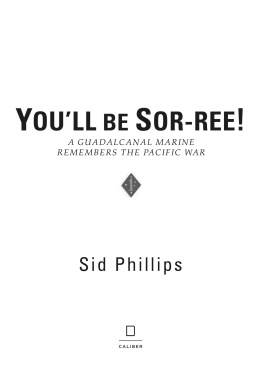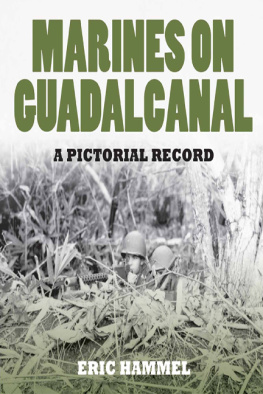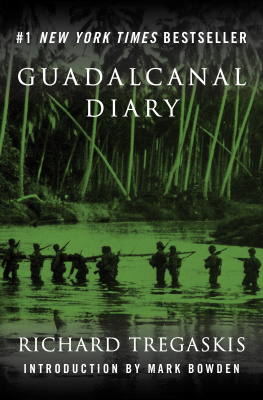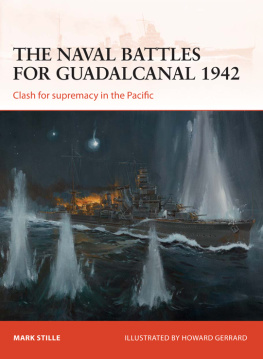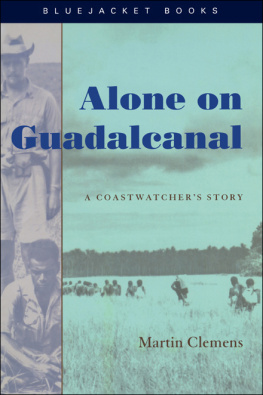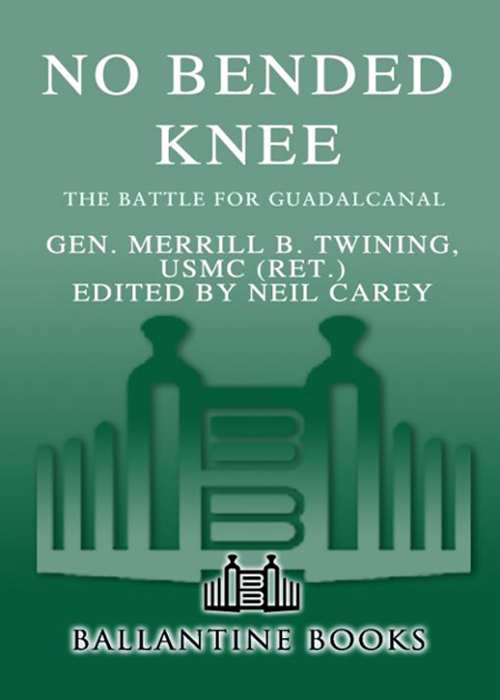
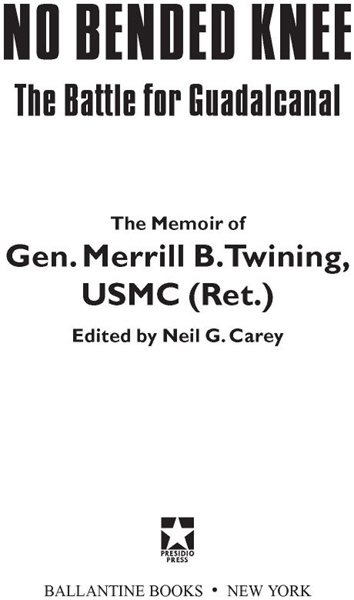
Table of Contents
To Betty Carey, whose encouragement, unflagginginterest, and continued enthusiasm made completionof this book a reality.
M. B. T.
... the bended knee is not a tradition of our Corps. If the Marine as a fighting man has not made a case for himself after 170 years of service, he must go. But I think that you will agree with me that he has earned the right to depart with dignity and honor, not by subjugation to the status of uselessness and servility planned for him by the War Department.
GEN. A. A. VANDEGRIFT, Commandant of the Marine Corps, testifying before the Senate Naval Affairs Committee, 6 May 1946.
More praise forNoBendedKnee
Guadalcanal is not the name of an island. It is the name of the graveyard of the Japanese army.
MAJ. GEN. KIYOTAKE KAWAGUCHI
Commander, 35th Infantry Brigade at Guadalcanal
The author enlightens his readers with the tactical and strategic essentials of the campaign, but he does it using the most human terms, incidents, and descriptions.
Marine Corps Gazette
Commanders should be counseled chiefly by persons of known talent, by those who have made the art of war their particular study, and whose knowledge is derived from experience, by those who are present at the scene of action, who see the enemy, who see the advantages that occasions offer, and who, like people embarked in the same ship, are sharers of the danger.
If, therefore, anyone thinks himself qualified to give advice respecting the war which I am to conductlet him not refuse the assistance to the State, but let him come with me into Macedonia.
He shall be furnished with a ship, a tent, even his traveling charges will be defrayed, but if he thinks this is too much trouble, and prefers the repose of a city life to the toils of war, let him not on land assume the office of a pilot. The city in itself furnishes abundance of topics for conversation. Let it confine its passion for talking to its own precincts and rest assured that we shall pay no attention to any councils but such as shall be framed within our camp.
GEN. LUCIUS A. PAULUS (229?160 B.C.) Rome
Acknowledgments
I thank the following individuals for their cooperation, assistance, and belief in this project:
Capt. James A. Barber, Jr., USN (Ret.), publisher, U.S. Naval Institute Proceedings, Annapolis, Maryland, for reassignment of article rights and years of correspondence.
Patrick Carney, chief librarian, base libraries, and Deanna Herrman, library technician, Camp Pendleton, California, for their professionalism and courtesy whenever I needed a book, a reference, or other information.
George B. Clark, the Brass Hat, of Pike, New Hampshire, for his encouragement and always ready supply of names and phone numbers of who to contact for information and photos.
Benis M. Frank, chief historian, History and Museums Division, Marine Corps Historical Center, Washington, D.C., for supplying photos and maps.
Col. John E. Greenwood, USMC (Ret.), editor, MarineCorps Gazette, Quantico, Virginia, for reassigning rights to an article of mine and supplying photos and maps.
Lt. Gen. Victor H. Krulak, USMC (Ret.), of San Diego, California, for graciously writing the foreword and for our many years of serving together in the Corps.
Maj. Walter R. Schuette, USMC (Ret.), the Village Wordsmith, Fallbrook, California, for transcribing much of my handwritten text into computer copy.
Kerry Strong, director of archives, Marine Corps Research Center, Quantico, Virginia, for her can-do response to requests for photographs.
Dale Wilson, former executive editor of Presidio Press, for his interest and helpful suggestions.
And those others, too numerous to mention by name, who gave encouragement, time, and information to make this project possible.
Foreword
Guadalcanal was an immense battleat sea, in the air, and most certainly on land. It was at this improbable place, an island in the southern Solomons chain, that the Americans and Japanese first slugged it out toe to toe in all three elements. The bitter struggle resulted in the loss of 1,200 aircraft, 49 ships, and as many as 35,000 American and Japanese lives. Although the issue was often in doubt, the Americans finally won. Major Gen. Kiyotake Kawaguchi, commander of the Japanese forces charged with destroying the U.S. Marine invaders, described his defeat for posterity in these words: Guadalcanal is not the name of an island. It is the name of the graveyard of the Japanese army.
Kawaguchi was correct. All of Japans victories occurred during the wars first year. After their defeat at Guadalcanal the Japanese never enjoyed another successful offensive. The gateway to Tokyo had been opened by the gallant menland, sea, and airwho fought on a shoestring and triumphed in that horrific campaign.
While much has been written about the actions on and around Guadalcanal, Marine Corps operations there have not, until now, received the detailed evaluative treatment they deserve. The principal written record from which historians usually take departure is the 1st Marine Divisions after-action report. Its sources were meager, many having been destroyed at the direction of Maj. Gen. Alexander A. Vandegrift at the low point of the battle when he believed it was likely his division would have to withdraw to the center of the island for a last-ditch fight. General Bill Twining wrote that report while recovering from malaria in Australiafar from many of the subordinate units whose contribution to the record would have been invaluable.
General Twining sets the historical record straight in this magnificent book by telling the Marines Guadalcanal story in all its painful reality. What he has written, without adjectival embellishment, is true military historywar with the bark on it. It is a story told in elegant detail, resounding with the ring of truth.
Bill Twining is the ideal man to tell this story. He was in the middle of it from the very beginning. He was a central personality in training the 1st Marine Division, the only U.S. ground force deemed professionally capable of carrying out Admiral Ernest J. Kings brave plan to stop the southward Japanese thrust toward New Guinea. When his superiors saw a need for an advance echelon to deal with the New Zealanders, Twining was selected to head it. When they wanted an aerial reconnaissance of the Guadalcanal objective area, Twining was chosen for the hazardous job. As first the assistant operations officer and later as the operations officer of the division, Twining was at the heart of its operational planning and an eyewitness to the most sensitiveand often traumaticexperiences of the end-of-the-line unit. He watched with revulsion the timidity of the overall tactical commander, VAdm. Frank Jack Fletcher, who wanted to convert the Guadalcanal operation into a hit-and-run raid and who took off after forty-eight hours, directing RAdm. Richmond K. Turner to depart, tootaking with him much of the Marines supplies and equipment.
Twining tells those bitter stories without emotion. He paints an eloquent picture of Marineson half-rations (much of which were captured from the Japanese), emaciated, and plagued by malariataking on the best the emperor had to offer as they defended precious Henderson Field. And he describes with unrestrained admiration the heroism of the Marine, army, and navy pilots who, flying patched-up planes, took to the air daily and triumphed against fearful odds.
Next page

